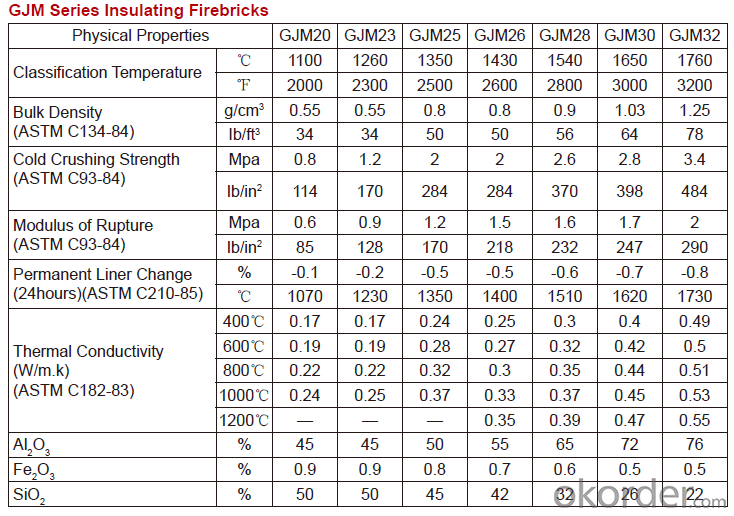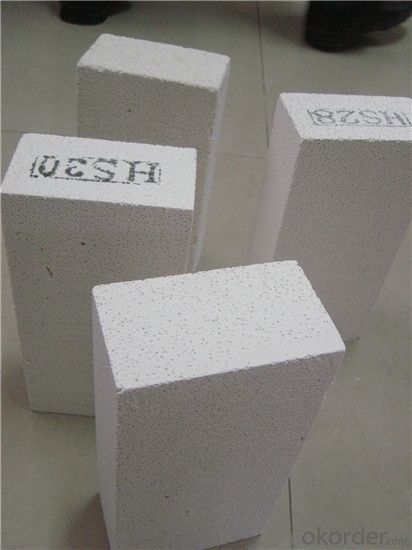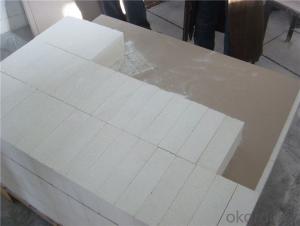GJM32 Fire Light Mullite Insulation Brick Product
- Loading Port:
- Shanghai
- Payment Terms:
- TT OR LC
- Min Order Qty:
- 1 m.t.
- Supply Capability:
- 10000 m.t./month
OKorder Service Pledge
OKorder Financial Service
You Might Also Like
Thermal Insulation Fire Clay Brick
Refractory brick is a refractory material used in lining furnaces, kilns, fireboxes, and fireplaces.
We provide high quality Refractory Fire Bricks that are used on wide range in the various industries like Cement, Glass and Steel. Refractory Fire Bricks are provided as per the quantity and specifications required by the customers. We provide an extensive range of Refractory Fire Bricks at reasonable prices that depend upon the quantity ordered.
Application
Insulating Fire Brick are used for the lining of converter, alternating current arc furnace, direct Current arc furnace and the ladle slag line, etc.
Company Advantage
(1)Long Insulating Fire Brick manufacture history: 25 years manufacturer
(2)Advanced equipment and good service
(3)Diversification of production standards: ISO ANSI FEPA JIS ASTM
(4)Flexible payment: T/T L/C D/P D/A
(5)Professional marketing team and after-sale service
Insulating Fire Brick main feature:

Equipment
1 unit of Ceramic Abrasive (SG Abrasive) pilot production line
2 units of Compact grain Abrasive pilot production lines
1 unit of high-end coated abrasives (abrasive cloth) production line
3 large flexible crushing and sieving lines for grit production lines
6 units of 5000KVA-10000KVA dumping type electric arc furnaces for Brown Fused Alumina fusion
FAQs
Q1 What’s the transport method?
A1 FCL delivery goods with wooden pallet or wooden case by sea; If LCL delivery, must with wooden case; Sometimes need open top, flat rack or bulk cargo.
Q2 What’s the required payment term?
A2 Generally 30% TT as the prepayment, 70% TT before delivery. If need, 100% Irrevocable Letter of Credit or negotiation.
Q3 Which country are our products exported to?
A3 Apart from entire Chinese market, the US, Russia, Japan, Korea, Australia and some Southeast Asian Nations.


- Q:Why does the water drop first and then rise when the boiler fires?
- This is the reason for the zero water level gauge line below the center line of the drum. Under normal conditions for water and evaporation is balanced, after the fire, reduce the amount of steam water mixture into the drum in the evaporation decreased rapidly, reduce the volume of water bubbles, sudden contraction, drum water level decreased rapidly. But not to water change or increase (automatic), water balance is broken, the water level will rise rapidly.
- Q:Can insulating fire bricks be used in the construction of heat recovery systems?
- Yes, insulating fire bricks can be used in the construction of heat recovery systems. Insulating fire bricks are designed to withstand high temperatures and provide excellent thermal insulation, making them an ideal choice for heat recovery systems. These bricks are made from lightweight materials, such as ceramic fibers or refractory materials, which have low thermal conductivity. This property allows them to effectively trap and retain heat, preventing it from escaping the system and maximizing energy efficiency. Additionally, insulating fire bricks are resistant to thermal shock, meaning they can withstand rapid temperature changes without cracking or breaking. This makes them suitable for the varying heat conditions often found in heat recovery systems. Overall, using insulating fire bricks in the construction of heat recovery systems can help improve their performance and efficiency by minimizing heat loss and optimizing energy recovery.
- Q:How do insulating fire bricks contribute to reducing heat loss?
- The unique thermal properties and design of insulating fire bricks aid in the reduction of heat loss. These bricks are composed of insulating materials, such as ceramic fibers or lightweight refractory aggregates, which possess low thermal conductivity. Consequently, they do not readily conduct heat, preventing the transfer of heat from one side of the brick to the other. Moreover, the structure of insulating fire bricks contains small air pockets or voids within the material. These air pockets function as barriers to heat, as air is a poor conductor of heat. As heat attempts to traverse the brick, it becomes trapped within these voids, significantly diminishing heat transfer. The insulating qualities of these bricks are beneficial in various applications, including industrial furnaces, kilns, and fireplaces. By utilizing insulating fire bricks as lining or insulation material, heat loss from these systems is minimized. This not only helps maintain a more consistent and uniform temperature within the enclosed space but also enhances energy efficiency by reducing wasted heat. Additionally, insulating fire bricks exhibit resistance to high temperatures, ensuring that they do not deteriorate or lose their insulating abilities when exposed to extreme heat. This durability enables them to provide long-lasting insulation and contribute to the reduction of heat loss over an extended period. In conclusion, insulating fire bricks are highly effective in decreasing heat loss due to their low thermal conductivity, presence of air pockets, and resistance to high temperatures. Their integration into various thermal systems aids in conserving energy, enhancing thermal efficiency, and creating a more comfortable and controlled environment.
- Q:Can insulating fire bricks be used for soundproofing?
- Insulating fire bricks are primarily used for thermal insulation in high-temperature applications, such as kilns and furnaces. While they may offer some level of sound absorption due to their porous nature, they are not specifically designed or recommended for soundproofing purposes. For effective soundproofing, specialized materials with higher sound absorption coefficients should be used.
- Q:How do insulating fire bricks perform in terms of thermal stability?
- Insulating fire bricks are known for their excellent thermal stability. They have a high resistance to thermal shock, meaning they can withstand rapid changes in temperature without cracking or breaking. Additionally, insulating fire bricks have low thermal conductivity, which allows them to effectively retain heat and provide insulation in high-temperature environments. Overall, their performance in terms of thermal stability is highly reliable.
- Q:What's the difference between refractory bricks and insulating bricks?
- In the preferred insulation performance, the thermal conductivity of insulating brick insulation brick in general 0.2-0.4 (average temperature 350 - 25 DEG C) w/m.k, and the thermal conductivity of refractory brick in 1 (the average temperature of 350 - 25 DEG C) above w/m.k, which can obtain the insulation performance of insulating brick than refractory brick insulation performance is much better. In the degree of refractoriness, the refractoriness of insulating bricks is generally below 1400 degrees, while the refractoriness of refractory bricks is above 1400 degrees. In density, insulation bricks are generally lightweight insulation materials, the density is generally in 0.8-1.0g/cm3, and the density of refractory bricks are basically above 2.0g/cm3.
- Q:Can insulating fire bricks be used as a lining material for boilers?
- Yes, insulating fire bricks can be used as a lining material for boilers. Insulating fire bricks are designed to withstand high temperatures and provide excellent insulation, making them suitable for use in boiler linings.
- Q:Can insulating fire bricks be used in the construction of lime production kilns?
- Yes, insulating fire bricks can be used in the construction of lime production kilns. Lime production kilns require high temperatures to convert limestone into lime, and insulating fire bricks are known for their ability to withstand and retain high temperatures. These bricks have high insulating properties, allowing the kiln to reach the desired temperature quickly and efficiently, while also minimizing heat loss during the production process. Insulating fire bricks are also lightweight and easy to handle, making them suitable for use in the construction of lime production kilns. Additionally, these bricks have good thermal shock resistance, meaning they can withstand rapid temperature changes without cracking or breaking, which is crucial in the kiln environment. Overall, the use of insulating fire bricks in the construction of lime production kilns can help optimize the efficiency and effectiveness of the lime production process.
- Q:Are insulating fire bricks resistant to ultraviolet radiation?
- No, insulating fire bricks are not resistant to ultraviolet radiation.
- Q:Are insulating fire bricks resistant to salt attack?
- Insulating fire bricks do not typically possess resistance against salt attack, which refers to the deterioration and corrosion of materials caused by salt or saltwater exposure. Although insulating fire bricks are engineered to have exceptional thermal insulation properties, they are not specifically formulated to endure the damaging effects of salt. Salt attack has the potential to weaken the structure of the bricks, leading to a decrease in their performance and durability over time. If these bricks are consistently exposed to salt or saltwater, it is probable that their degradation will be hastened, making them unreliable for long-term use in such environments. To ensure resilience against salt attack, it is advised to utilize refractory materials specially designed for this purpose, such as salt-resistant fire bricks or refractories with a higher alumina content. These materials have been developed to withstand the corrosive impacts of salt and are better suited for applications where exposure to salt or saltwater is anticipated.
1. Manufacturer Overview |
|
|---|---|
| Location | |
| Year Established | |
| Annual Output Value | |
| Main Markets | |
| Company Certifications | |
2. Manufacturer Certificates |
|
|---|---|
| a) Certification Name | |
| Range | |
| Reference | |
| Validity Period | |
3. Manufacturer Capability |
|
|---|---|
| a)Trade Capacity | |
| Nearest Port | |
| Export Percentage | |
| No.of Employees in Trade Department | |
| Language Spoken: | |
| b)Factory Information | |
| Factory Size: | |
| No. of Production Lines | |
| Contract Manufacturing | |
| Product Price Range | |
Send your message to us
GJM32 Fire Light Mullite Insulation Brick Product
- Loading Port:
- Shanghai
- Payment Terms:
- TT OR LC
- Min Order Qty:
- 1 m.t.
- Supply Capability:
- 10000 m.t./month
OKorder Service Pledge
OKorder Financial Service
Similar products
New products
Hot products
Related keywords



























